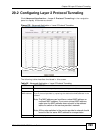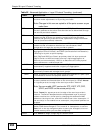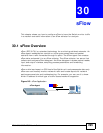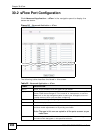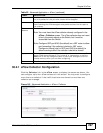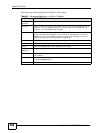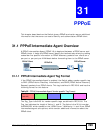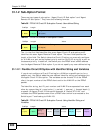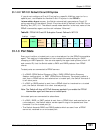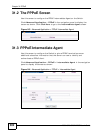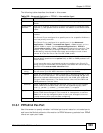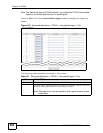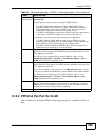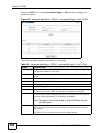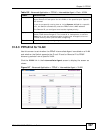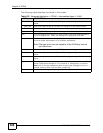
Chapter 31 PPPoE
XGS-4526/4528F/4728F User’s Guide
301
31.1.2.2 WT-101 Default Circuit ID Syntax
If you do not configure a Circuit ID string for a specific VLAN on a port or for a
specific port, and disable the flexible Circuit ID syntax in the PPPoE >
Intermediate Agent screen, the Switch automatically generates a Circuit ID
string according to the default Circuit ID syntax which is defined in the DSL Forum
Working Text (WT)-101. The default access node identifier is the host name of the
PPPoE intermediate agent and the eth indicates “Ethernet”.
31.1.3 Port State
Every port is either a trusted port or an untrusted port for the PPPoE intermediate
agent. This setting is independent of the trusted/untrusted setting for DHCP
snooping or ARP inspection. You can also specify the agent sub-options (circuit ID
and remote ID) that the Switch adds to PADI and PADR packets from PPPoE
clients.
Trusted ports are connected to PPPoE servers.
• If a PADO (PPPoE Active Discovery Offer), PADS (PPPoE Active Discovery
Session-confirmation), or PADT (PPPoE Active Discovery Terminate) packet is
sent from a PPPoE server and received on a trusted port, the Switch forwards it
to all other ports.
• If a PADI or PADR packet is sent from a PPPoE client but received on a trusted
port, the Switch forwards it to other trusted port(s).
Note: The Switch will drop all PPPoE discovery packets if you enable the PPPoE
intermediate agent and there are no trusted ports.
Untrusted ports are connected to subscribers.
• If a PADI, PADR, or PADT packet is sent from a PPPoE client and received on an
untrusted port, the Switch adds a vendor-specific tag to the packet and then
forwards it to the trusted port(s).
• The Switch discards PADO and PADS packets which are sent from a PPPoE
server but received on an untrusted port.
Table 99 PPPoE IA Circuit ID Sub-option Format: Defined in WT-101
SubOpt Length Value
0x01
(1 byte)
N
(1 byte)
Access
Node
Identifier
(20 byte)
Space
(1
byte)
eth
(3
byte)
Space
(1
byte)
Slot
ID
(1
byte)
/
(1
byte)
Port No
(2
byte)
:
(1
byte)
VLAN
ID
(4
bytes)



